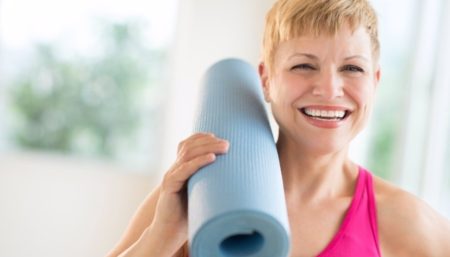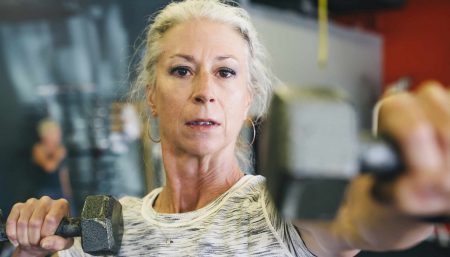Bone density is of concern to women as they reach mid-life because women have a higher rate of osteoporosis and subsequent fractures. Women are at greater risk because: we loose bone mass after menopause, we start out with smaller bones, and we live longer. At about age 35, you have what is called Peak Bone Mass–your bones are as dense and strong as they will be. Before that time, the renewal phase was greater than the breakdown. Starting in the later thirties and continuing into the forties and beyond, this ratio reverses, so that about 1% of bone mass is lost each year.

Keeping a watch on calcium intake, vitamin D, limiting alcohol, smoking and caffeine and indulging in weight-bearing exercise you can keep bones stronger, longer. Below is a series of back, leg and arm exercises to load your skeleton in ways that should optimize your BMD. There are also balance exercises to help reduce your risk of falls. Between them these exercises will reduce your risk of fracture.
1. Flamingo Swing
-
Stand sideways to a chair, holding the chair-back for support. Stand tall, with your feet slightly apart and your weight distributed evenly between both feet. Relax your other arm by your side. Check your pelvic tilt and lift up out of your hips.
-
Transfer your weight on to the leg nearest to the chair. Slide your other foot forward, keeping your toes in contact with the floor. Lift the extended leg about 5 cm off the floor.
-
Keeping both knees soft, swing the extended leg gently backward in a controlled sweeping motion, keeping it close to your body.
-
Keep both hips facing forward as you swing your leg forward. Do not allow your back to arch. Repeat 6 times. Turn and repeat on the other leg.
2. TANDEM STAND & WALKS
- Tandem stand
1. Stand sideways to a wall and place one hand on the wall for support. Relax your other arm by your side. Stand tall, check your pelvic tilt and tighten your abdominals.
2. Place the foot nearest the wall directly in front of the other so your feet from a straight line. Hold for 10 seconds. Repeat with your other foot in front. Turn to face the other direction and repeat steps 1 and 2.
2. Tandem walk
Use a wall for support. Place one foot directly in front of the other so your feet form a straight line. Develop this movement into continuous walking. Take 10 steps, turn slowly and repeat in the other direction.
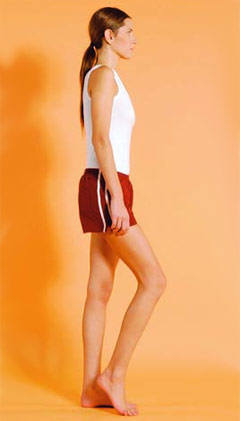 3. Toe Walks
3. Toe Walks
-
Stand sideways to a wall, and place one hand on the wall for support. Relax your other arm by your side. Stand tall and check your pelvic tilt.
-
Lift your heels and transfer your body weight on to the balls of your feet.
-
Using the wall as support, walk 10 steps on your toes. Then bring both feet together by stepping in with your back foot. Lower your heels to the ground and turn around. Rise on your toes and walk 10 steps in the other direction. Turn and repeat.
4. Back Lift
-
Lie face-down on the floor, your legs together, your arms by your side and your palms on the floor. Check your pelvic tilt..
-
Lengthen your spine and lift your shoulders, back and head off the floor. Moving slowly and with control, count to 5 to lower. Rest for 5 before repeating. Lift your palms just off the floor for an extra challenge.
5. Flying Back Lift
-
Lie face-down with your forehead on your folded hands. Check your pelvic tilt and tighten your abdominals.
-
Slide one palm forward along the ground. Lengthen your opposite leg along the floor away from your body.
-
Tighten you buttock muscles on this side, then lift your leg about 5 cm off the floor. Maintain this position as you lengthen and lift your outstretched arm about 3 cm. Count to 5 to lift, hold and count to 5 to lower. Rest, then repeat on the other side.
6. Leg Lift
-
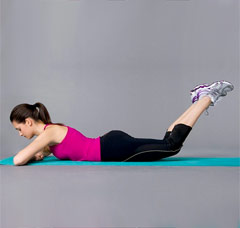 Lie face-down with your legs together and your forehead on your folded hands. Check your pelvic tilt and tighten your abdominals.
Lie face-down with your legs together and your forehead on your folded hands. Check your pelvic tilt and tighten your abdominals. -
Lengthen one leg away from you along the floor, tighten your buttock muscles on this side and, keeping both hips pressed into the floor, lift your leg about 3 cm. Lengthen and left another 3 cm upward, then lower. Count to 3 to lift, hold, count to 3 to lower. Rest, then repeat on the other side.
7. Side Leg Lift
-
Lie sideways with your knees and hips at right angles, with weight around your ankles. Rest your head on your lower arm or a cushion for comfort. Place your other hand on the mat, opposite your chest. Check your pelvic tilt and tighten your abdominals.
-
Taking care to keep your knee and foot facing forward and slightly down, raise your top leg about 10 cm. Count to 3 to lift, hold, count to 3 to lower. Rest, then repeat. Roll over on to your other side and repeat with your other leg.
8. Thigh Squeeze
-
Sit tall facing a partner, with your legs outside her legs. Both of your must position your knees directly over your pelvic tilt and tighten your abdominals.
-
Slowly press your legs inwards, as your partner presses outwards. Count to 3 as you press, hold, count to 3 to release. Rest, then repeat.
-
Rest, then change positions and repeat.
9. Wrist Curl
-
Sit toward and front of the chair with your feet hip-width apart and your knees over knees over your ankles. Hold a dumb-bell in an underhand grip, with your wrist horizontal and in line with your elbow. Support your forearm with your other hand, resting it on your thigh. lean forward slightly.
-
Count to 3 to curl the dumb-bell upward, moving only your wrist hold.
-
Count to 3 to lower the weight until your wrist is fully extended downward, and return it the start position. Rest, then repeat. Repeat with your other arm.
-
Turn your forearm over and repeat the exercise using an overhand grip.
10. Shoulder Press
-
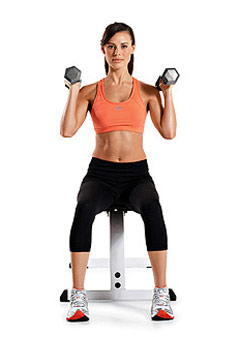 Sit with your feet and legs hip-width apart. Hold the dumb-bells in a ‘thumb under’ grip with your elbows bent and your hands a little wider than shoulder-width apart. Your palms should face forward with your knuckles up toward the ceiling. Check your pelvic tilt and tighten your abdominals.
Sit with your feet and legs hip-width apart. Hold the dumb-bells in a ‘thumb under’ grip with your elbows bent and your hands a little wider than shoulder-width apart. Your palms should face forward with your knuckles up toward the ceiling. Check your pelvic tilt and tighten your abdominals. -
Press the dumb-bells directly up until your arms are as straight as possible but not locked. Count to 3 as you left, hold, count to 3 as you lower to the start position. Rest, then repeat.
Bones need a challenge to make them strong. Weight-bearing exercises give them that challenge by causing your bones and muscles to work against gravity. In activities like jogging, jumping, tennis or soccer, your feet and legs absorb the impact of your weight against the force of gravity. This stimulates the bones in your hips and spine, and helps to build density and strength in the areas that are most vulnerable to the loss of bone mass. Experts recommend moderate exercise three to four times a week to prevent and manage osteoporosis.
Disclaimer
The Content is not intended to be a substitute for professional medical advice, diagnosis, or treatment. Always seek the advice of your physician or other qualified health provider with any questions you may have regarding a medical condition.
